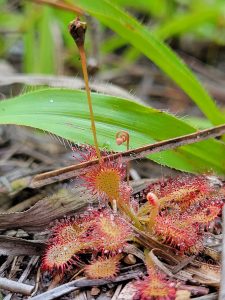Plants that grow in tropical environments (such as Florida) are faced with nutrient deficient soils. Many of the swamps and bogs, wet flatwoods, and even dry mesic flatlands are poor in Nitrogen and Phosphorus. These elements are essential for growth. Luckily these areas are also home to many insects which are rich sources of Nitrogen, protein and other elements needed for the plant to flourish. Enter Carnivorous Plants – plants that eat animals!
There are 5 main groups of carnivorous plants that capture prey with clever methods, all evolving separately, all based upon modified leaves. These leaves have developed ways to not only capture pray, but also release chemicals to digest and absorb the prey. Pitcher plants, sundews, bladderworts, and butterworts have Florida native species, and the non-native Venus Flytraps have introduced species.
Pitcher Plants (Sarracenia spp.) have 6 Florida native species, with only S. minor residing in Central Florida. They have funnel-shaped leaves and a hood, also known as operculum. These hoods often with opaque windows and distinctive coloration to attract prey. The insects are attracted to the slippery leaf rim, known at the peristome, that offers nectar attractant. Prey then fall into the funnel which is lined with downward-facing hairs that prevent the insect from escaping. The captured prey is digested by the enzymes within the leaf funnel. Flowers are individual (1-4”) and colorful (yellow to deep purple petals), propped on long 1-3 feet stalks, hang freely and face downwards with a modified pistil. These long flower stalks prevent the pollinators from becoming dinner. Bees frequent visit different species, encouraging many natural hybrids.

Sundews (Drosera spp.) are represented with 5 Florida native species. Leaves are paddle-shaped or long filiform with distinctive long trichomes (modified hairs) that excrete a very sticky glue. This clear glue creates a beaded trap for small insects. Three paddle-shaped species, D. brevifolia, D. capillaris, and D. intermedia can be found in Central Florida; the other 2 filiform species reside in the panhandle areas. So, the next time you are hiking through a boggy wet area, even a low area under trees that holds water, look for these inconspicuous reddish rosettes.

Bladderworts (Utricularia spp.) have 14 Florida native species. They are aquatic carnivorous plants with small, divided leaves that appear moss-like underwater; all are rootless! Flowers are very small (1-2cm), two-lipped petals, yellow or pink, and with a spur. The inflorescence extends above the water a few centimeters. Numerous plants will display numerous flowers in a small area. Each leaf has dozens of tiny water-filled bladders (1-3mm), each bladder equipped with a hair trigger and a trap door. When tiny insects, protozoa, dinophytes and rotifers touch the hair trigger, the trap door swiftly closes, and the prey is sucked into the chamber. The creature is dissolved and absorbed by the bladderwort.

Butterworts (Pinguicula spp.) are native to the drier, nutrient-poor uplands of Florida. Thick fleshy leaves are arranged in a rosette and have minute surface hairs that exude a sticky substance. Small prey such as fungus gnats get stuck in the goo and are digested by enzymes. There are 6 Florida native species. P. caerulea (violet flowers) and P. lutea (yellow flowers) reside in Central Florida.
Venus Flytraps (Dionaea spp.) are not native to Florida but are the most popular and well-known carnivorous plant. Flytraps have modified leaves tips shaped in two opposing lobes with “claw” appendages on the end. The lobes present an insect attracting odor, often backed by bright red-orange coloration. The inside of each lobe has a few hairs that are sensitive to insect movements. When the insect brushes against these hairs, the lobes are triggered to close around the insect, trapping the bug with its thick hair claws. The inner lobes will produce enzymes to breakdown the insect, then absorb the resultant soupy nutrients. There are naturalized colonies in the Florida panhandle that were started in the 1970s by a resident spreading seeds.
The culture of carnivorous plants is unusually simple. Remember, carnivorous plants evolved in nutrient poor environments – dry and sandy upland forests to mucky bogs and swamps to oxygen-poor lakes and canals. Plant your specimens with media low in fertility, such as pure sphagnum peat moss, coir (shredded coconut husks), builders’ sand, long-fibered sphagnum moss. You may pot your plant into individual plastic pots or plant several specimens together into larger well drained, plastic trays. Keep the media moist.
Fertilization should be avoided; no plant food at all. The media will naturally present a low pH environment for your carnivorous plants, so no amendments. And finally, mostly full sun for young plants and full sun for mature specimens.
Grow your carnivorous plants outdoors … they will feed themselves!
This post was written with the help of one of our Lake County Master Gardener Volunteers. Thank you!
References/Additional Resources
Adams, C.J., L. Reynolds, C.W. Martin, C. Rohal, R. Goebel, and J. Slater. 2023. “Common Wetland and Aquatic Plants of Lake Apopka, Florida (USA).” ENH1363 https://edis.ifas.ufl.edu/publication/EP627
Biss, J. 2016. “Florida’s Aquatic Carnivorous Plants – Yes, Aquatic!” https://blogs.ifas.ufl.edu/calhounco/2016/06/03/floridas-aquatic-carnivorous-plants-yes-aquatic/
Brown, M.E. and D.L. Miller. 2019. “Native Pitcherplants of Florida”. WEC333. https://edis.ifas.ufl.edu/publication/UW378
Brown, M.E. and D.L. Miller. 2018. “Florida’s Seepage Slope Wetlands”. WEC322. https://edis.ifas.ufl.edu/publication/UW367
Coogan, K. 2022. Florida’s Carnivorous Plants. Pineapple Press, Palm Beach, FL. https://kennycoogan.com/
Miller, J. 2019. “The Florida Flytrap Mystery is Solved”. Carnivorous Plant Newsletter Vol. 48 No. 3 September 2019. https://cpn.carnivorousplants.org/articles/CPNv48n3p135.pdf
Miller, P. 2018. “Beautiful Butterworts: Butterworts of Kissimmee Prairie Preserve”. Friends of Kissimmee Prairie Preserve. https://www.kissimmeeprairiefriends.org/prairie-blog/butterworts-of-kissimmee-prairie-preserve-by-paul-miller
O’Conner, R. 2012. “Bogs in Northwest Florida”. https://blogs.ifas.ufl.edu/escambiaco/2012/08/31/bogs-in-northwest-florida/
Stevenson, C. “Weekly “What Is This?: Sundews”. 2020. https://blogs.ifas.ufl.edu/escambiaco/2020/05/27/weekly-what-is-it-sundews/
Stevenson, C. “Weekly “What Is This?: Threadleaf Sundews”. 2022. https://blogs.ifas.ufl.edu/escambiaco/2022/05/11/weekly-what-is-it-threadleaf-sundew/
 1
1
